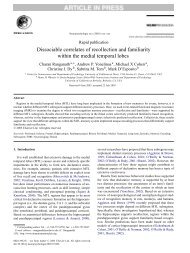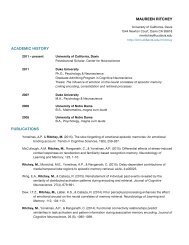CLINICAL EEG and NEUROSCIENCE - Dynamic Memory Lab
CLINICAL EEG and NEUROSCIENCE - Dynamic Memory Lab
CLINICAL EEG and NEUROSCIENCE - Dynamic Memory Lab
Create successful ePaper yourself
Turn your PDF publications into a flip-book with our unique Google optimized e-Paper software.
<strong>CLINICAL</strong> <strong>EEG</strong> <strong>and</strong> <strong>NEUROSCIENCE</strong> ©2007 VOL. 38 NO. 1Table 1Examples of spatial ordering of ROIs for the superior frontal gyrus <strong>and</strong> the middle occipital gyrusSuperior Frontal GyrusMiddle Occipital GyrusRegion (mm) Region (mm)MFG Medial Frontal Gyrus 17.63 IOG Inferior Occipital Gyrus 13.96MidFG Middle Frontal Gyrus 20.82 SOG Superior Occipital Gyrus 20.47AC Anterior Cingulate 26.24 AG Angular Gyrus 29.91IFG Inferior Frontal Gyrus 40.21 LG Lingual Gyrus 30.03EN Extra-Nuclear 48.66 Cu Cuneus 31.64PreCG Precentral Gyrus 52.96 PC Posterior Cingulate 38.38SG Subcallosal Gyrus 51.08 SMG Supramarginal Gyrus 43.02CG Cingulate Gyrus 53.33 FG Fusiform Gyrus 44.56OG Orbital Gyrus 51.68 PCu Precuneus 45.84RG Rectal Gyrus 52.77 MTG Middle Temporal Gyrus 48.94In Insula 55.48 IPL Inferior Parietal Lobule 50.95SubG Sub-Gyral 70.97 SPL Superior Parietal Lobule 52.28TTG Transverse Temporal Gyrus 70.06 SubG Sub-Gyral 58.55PCG Postcentral Gyrus 72.97 PHG Parahippocampal Gyrus 59.42STG Superior Temporal Gyrus 71.42 ITG Inferior Temporal Gyrus 60.37Un Uncus 72.51 PCG Postcentral Gyrus 63.26PCL Paracentral Lobule 76.40 STG Superior Temporal Gyrus 63.46PHG Parahippocampal Gyrus 76.13 TTG Transverse Temporal Gyrus 67.00IPL Inferior Parietal Lobule 88.27 In Insula 72.50MTG Middle Temporal Gyrus 87.54 PCL Paracentral Lobule 74.46ITG Inferior Temporal Gyrus 89.62 CG Cingulate Gyrus 80.05SMG Supramarginal Gyrus 95.80 PreCG Precentral Gyrus 81.57PC Posterior Cingulate 96.81 Un Uncus 83.70FG Fusiform Gyrus 96.36 EN Extra-Nuclear 91.62SPL Superior Parietal Lobule 102.72 SG Subcallosal Gyrus 93.98PCu Precuneus 104.04 IFG Inferior Frontal Gyrus 103.83AG Angular Gyrus 108.61 MidFG Middle Frontal Gyrus 111.36LG Lingual Gyrus 115.04 AC Anterior Cingulate 114.05Cu Cuneus 119.81 MFG Medial Frontal Gyrus 116.70SOG Superior Occipital Gyrus 122.93 RG Rectal Gyrus 119.03MOG Middle Occipital Gyrus 122.70 SFG Superior Frontal Gyrus 122.70IOG Inferior Occipital Gyrus 127.90 OG Orbital Gyrus 133.22order to reduce the number of variables, adjacent frequency0.5 Hz b<strong>and</strong>s were averaged to produce a 1 Hzresolution thus yielding a total of 40 frequency b<strong>and</strong>sfrom 1 to 40 Hz. The Key Institute software was used tocompute the T matrix according to the Talairach A t l a scoordinates of the Montreal Neurological Institute’s MRIaverage of 305 brains. 1 2 - 1 6 Based on the equations of theKey Institute 1 5 the diagonal elements (autospectrum) ofthe Hermitian cross-spectral matrix were multiplied by theT matrix at each 1 Hz frequency b<strong>and</strong> for each 2 secondepoch. The T matrix is a 3-dimensional matrix of x, y <strong>and</strong>z current source moments in each of the 2,394 gray matterpixels. The resultant current source vector at eachvoxel was computed as the square root of the sum of thesquares for the x, y <strong>and</strong> z source moments for each 1 Hzfrequency b<strong>and</strong>.Regions of interest (ROIs)The anatomical names <strong>and</strong> Brodmann areas that correspondto each of the 2,394 gray matter pixels in TalairachAtlas coordinates was provided by Lancaster et al 16 asused by the Key Institute software, Pascual-Marqui. 15 TheKey Institute’s first best match to a given region of interest(ROI) was used for both Brodmann area values <strong>and</strong>anatomical names. After computing the LORETA sourcecurrents for each of the 2,394 gray matter pixels the Key-Talairach table of gray matter pixels was sorted by anatomicalname <strong>and</strong> an average current source density for agiven ROI was computed by summing the current valuesfor each of the gray matter pixels in an ROI <strong>and</strong> then dividingby the number of pixels. This resulted in a total of 66different averages of current source density for each 2 secondepoch (33 ROIs from the left hemisphere <strong>and</strong> 33 ROIs37




